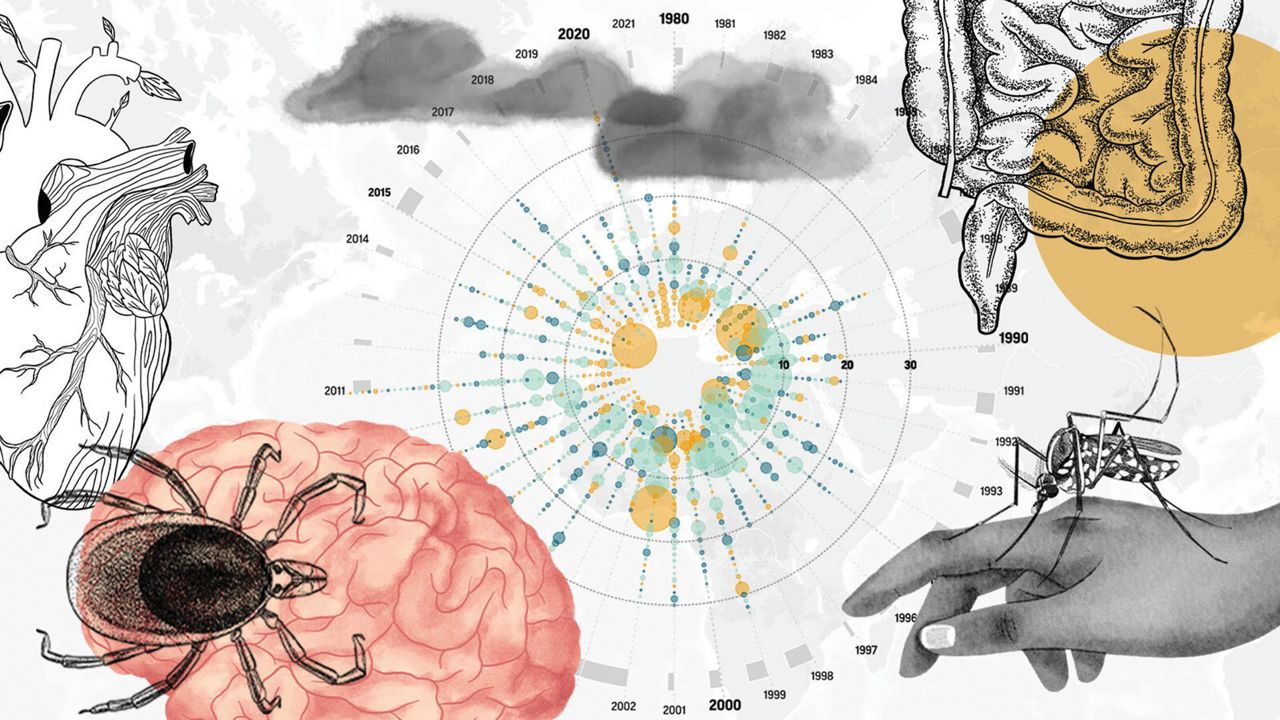NEW YORK (AP) — People around the world are living longer, healthier lives than they were just half a century ago.
Climate change threatens to undo that progress.
Across the planet, animals — and the diseases they carry — are shifting to accommodate a globe on the fritz. And they’re not alone: Ticks, mosquitos, bacteria, algae, even fungi are on the move, shifting or expanding their historical ranges to adapt to climatic conditions that are evolving at an unprecedented pace.
These changes are not happening in a vacuum. Deforestation, mining, agriculture, and urban sprawl are taking bites out of the globe’s remaining wild areas, contributing to biodiversity loss that’s occurring at a rate unprecedented in human history. Populations of species that humans rely on for sustenance are dwindling and getting pushed into ever-smaller slices of habitat, creating new zoonotic-disease hotspots. Meanwhile, the number of people experiencing extreme repercussions of a warming planet continues to grow. Climate change displaces some 20 million people every year — people who need housing, medical care, food, and other essentials that put strain on already-fragile systems that are growing ever more stressed.
All of these factors create conditions ripe for human illness. Diseases old and new are becoming more prevalent and even cropping up in places they’ve never been found before. Researchers have begun piecing together a patchwork of evidence that illuminates the formidable threat climate-driven diseases currently pose to human health — and the scope of the dangers to come.
“This is not just something off in the future,” Neil Vora, a physician with the nonprofit Conservation International, said. “Climate change is here. People are suffering and dying right now.”
___
EDITOR'S NOTE: This story is part of a collaboration between The Associated Press and Grist exploring the intersection of climate change and infectious diseases.
___
Research shows that climate change influences the spread of disease in a few major ways.
To escape rising temperatures in their native ranges, animals are beginning to move to higher, cooler elevations, bringing diseases with them. That poses a threat to people living in those areas, and it also leads to dangerous intermingling between animal newcomers and existing species. Bird flu, for example, has been spreading with greater ease among wild animals as rising seas and other factors push nesting bird species inland, where they’re more likely to run into other species. Diseases that jump between species tend to have an easier time eventually making the leap to humans.
Warmer winters and milder autumns and springs allow carriers of pathogens — ticks, mosquitos, and fleas, for example — to remain active for longer swaths of the year. Expanded active periods mean busier mating seasons and fewer casualties over the cold winter months. The Northeastern United States has seen a massive proliferation of Lyme disease-carrying black-legged ticks over the past decade, with warmer winters playing a decisive role in that trend.
Erratic weather patterns, such as periods of extreme drought and flooding, create conditions for diseases to spread. Cholera, a water-borne bacteria, thrives during the monsoon season in South Asian countries when flooding contaminates drinking water, especially in places that lack quality sanitation infrastructure. Valley fever, a fungal-borne pathogen that grows in the soil in the Western U.S., flourishes during periods of rain. The severe drought that tends to follow rain in that part of the world shrivels the fungal spores, which allows them to more easily disperse into the air at the slightest disturbance — a hiker’s boot, say, or a garden rake — and find their way into the human respiratory system.
These climate-driven impacts are taking a serious toll on human health. Cases of disease linked to mosquitos, ticks, and fleas tripled in the U.S. between 2004 and 2016, according to the Centers for Disease Prevention and Control. The threat extends beyond commonly recognized vector-borne diseases. Research shows more than half of all the pathogens known to cause disease in humans can be made worse by climate change. The problem compounds as time goes on. The World Health Organization estimates that between 2030 and 2050, just a handful of climate-related threats, such as malaria and water insecurity, will claim a quarter of a million additional lives each year.
“I think we’ve drastically underestimated not only how much climate change is already changing disease risks, but just how many kinds of risks are changing,” said Colin Carlson, a global change biologist at Georgetown University.
He noted that while connecting the dots between tick-borne illnesses and climate change, for example, is a relatively straightforward scientific endeavor, the scientific community and the general public need to be aware that the impacts of global warming on disease can also manifest in many other, less obvious ways. The COVID-19 pandemic is an example of how quickly disease can move through global populations and how deeply complicated the public health response to such threats can get.
“I think there’s a lot more to worry about in terms of epidemic and pandemic threats,” he said.
The world has the tools it needs — wildlife-surveillance networks, vaccines, early-warning systems — to mitigate the impacts of climate-driven disease. Some of these tools have already been deployed on a local scale to great effect. What remains to be seen is how quickly governments, NGOs, medical providers, doctors, and the public can work across borders to develop and deploy a global plan of action.
____
Associated Press climate and environmental coverage receives support from several private foundations. See more about AP’s climate initiative here. The AP is solely responsible for all content.
Copyright 2023 The Associated Press. All rights reserved. This material may not be published, broadcast, rewritten or redistributed without permission.




